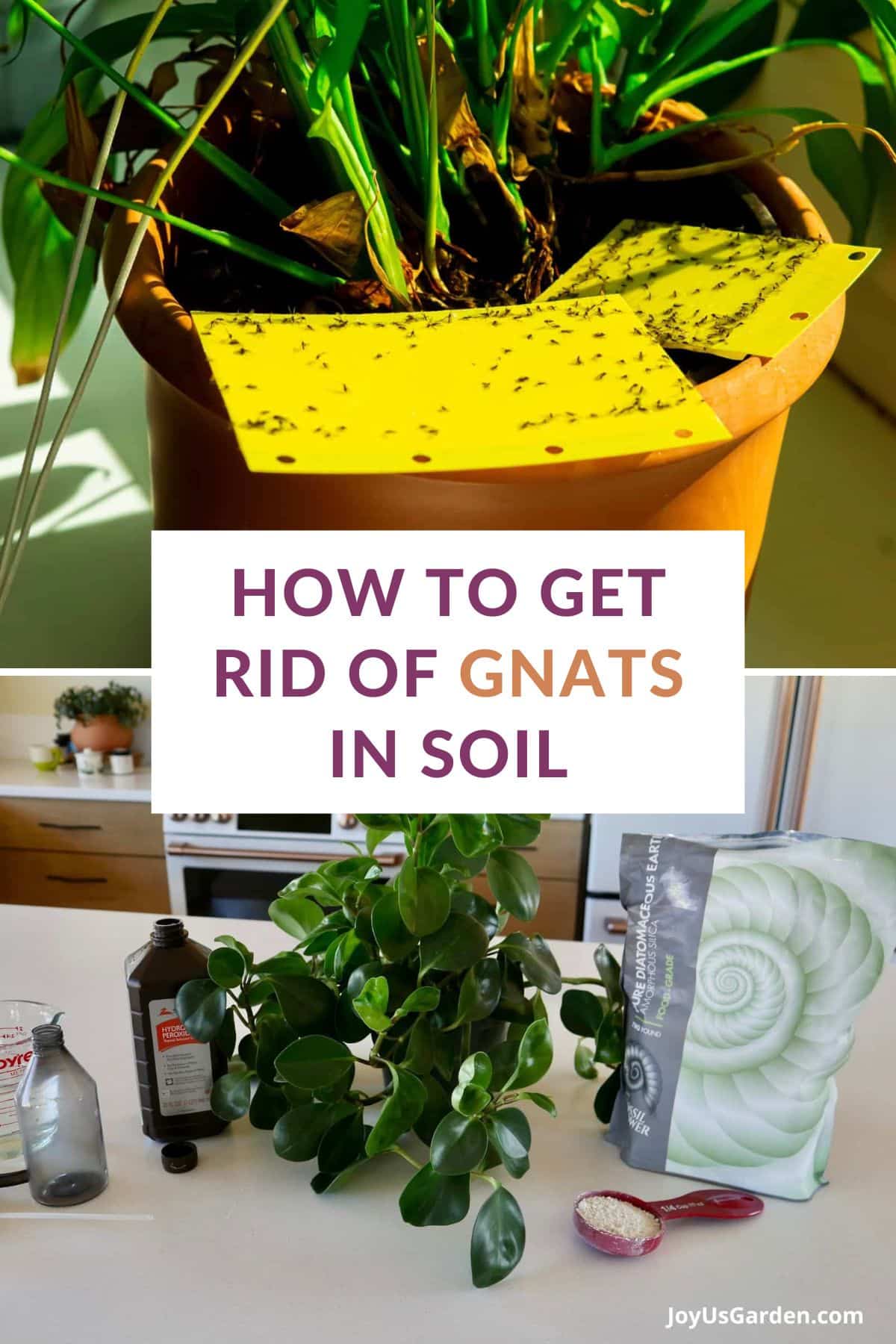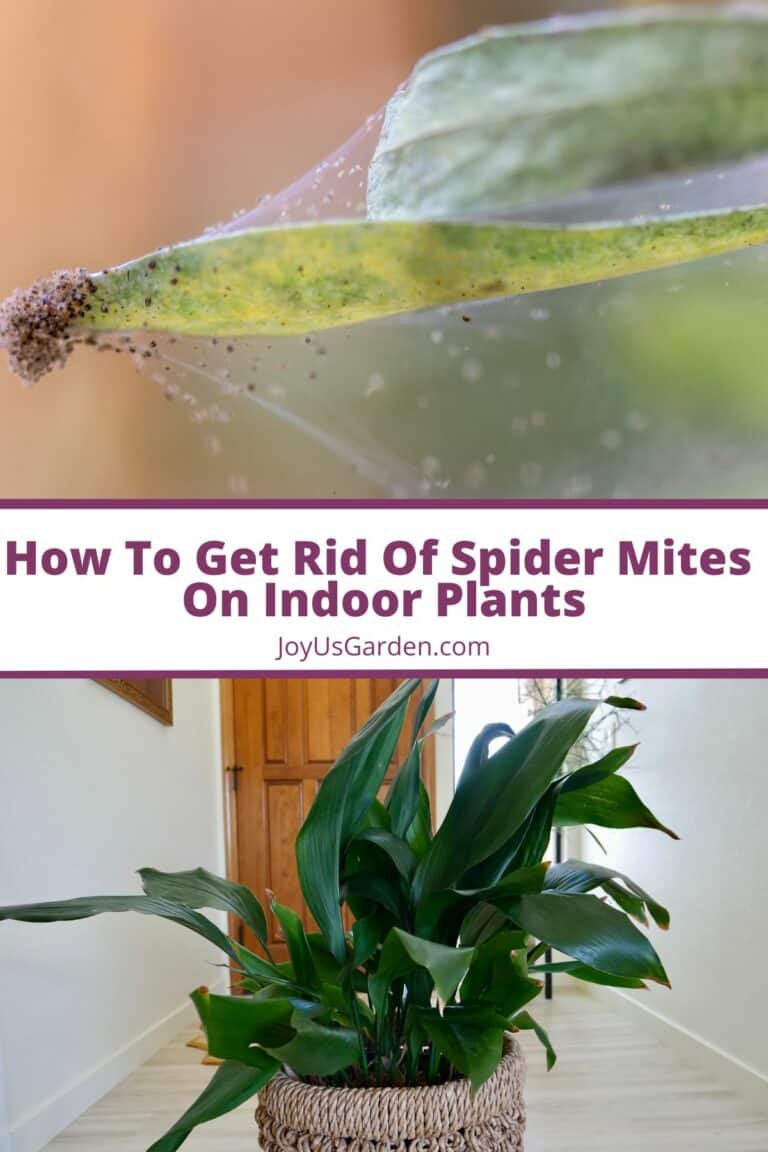How To Get Rid Of Gnats in Soil
If you’ve kept indoor plants for any length of time, chances are you’ve encountered fungus gnats. These common houseplants pests don’t cause as much damage as spider mites and scale, and most plant lovers consider fungus gnats mostly a nuisance.
However, if fungus gnat populations soar, fungus gnat larvae can damage plant roots, and adult gnats can also transmit damping off to young plants.
While fungus gnats are certainly troublesome, the good news is that these pests can be easily managed by adjusting your plant care regimen. Below, you’ll discover the best ways to tackle a fungus gnat infestation to keep your house plants gnat-free and pristine for many years to come!
This post may contain affiliate links, you can read our policies here.
What Are Fungus Gnats?
Fungus gnats are small, flying insects that look much like fruit flies. However, unlike other small flies, fungus gnats have long legs and thin bodies, and their flight pattern is quite erratic.
Adult fungus gnats are about the same size as fruit flies, and they have grayish-black bodies and gray or transparent wings, while fungus gnats in the larval stage look like small, transparent worms with shiny black heads.
Feeding on organic matter, old plant material, and fungi in plant soil, small numbers of fungus gnats are relatively harmless, and they don’t sting, bite, or directly damage plants.
However, large numbers of fungus gnats can destroy plant roots and cause other issues. Worse still, fungus gnats have the irritating habit of flying up in your face (or into your drink!) when watering your plants!
What Causes Gnats?
Fungus gnats may hitch a ride on new plants purchased from garden centers or can fly into your home through an open window. But what really attracts fungus gnats is overwatering.
Fungus gnats love moist soil, and if a fungus gnat problem crops up in your houseplant collection, chances are you will need to adjust your watering regimen.
Not only do overwatered plants provide the perfect habitat for fungus gnats, but soggy soil is also a breeding ground for fungus and root rot.
Identifying Gnats On Houseplants and Indoor Plants
Fungus gnats don’t fly very well, so they spend most of their time hovering near the top layer of soil in potted plants. You may also see fungus gnats congregating in the damp potting mix around the drainage holes of plant pots.
If you’re still unsure you’re dealing with fungus gnats, give your houseplants a gentle shake. If small insects fly out of your plants, there’s a good chance you’re dealing with soil gnats.
Another option is to lay potato slices on the top of the soil of your houseplants and check the slices in the morning for signs of fungus gnat larvae.
How To Prevent Fungus Gnats
The best way to keep fungus gnats at bay is to avoid overwatering houseplants. Fungus gnats thrive in damp soil, and they feed on fungus that grows in overly moist conditions.
However, if the soil surface is allowed to dry out a bit between plant waterings, fungus gnat adults won’t be as keen to lay their eggs, and their populations won’t grow as rapidly.
Since different plants have different watering needs, it can be tricky to know exactly when and how much to water houseplants. However, a good rule of thumb is that tropical houseplants should be watered when the top one to two inches of soil feels dry to the touch, and succulents and cacti need to be watered much less than that. And, of course, keep plants in pots with plenty of drainage holes!
Aside from adjusting how you water plants, you can prevent fungus gnats by checking new plants over well and quarantining new additions for a couple of days before you add them to your houseplant collection. If in doubt, you can also spray new houseplants with a mild soap spray made with water and a few drops of dish soap to make sure you’re not bringing fungus gnats or other pests into your home.
You might find this guide to watering indoor plants helpful, especially if you are a beginner.
Damage Caused By Fungus Gnats
Small populations of fungus gnats won’t do much harm to plants. But if fungus gnats reproduce rapidly, large numbers of larvae will begin to feed on plant roots, which can cause significant harm, especially to young plants and seedlings. Damage from fungus gnat larvae looks similar to the symptoms of root rot, and infected plants may wilt, and their leaves may droop, yellow, and drop away.
Aside from root issues, fungus gnats can also transmit damping off, a particularly devastating disease in seedling grow rooms. When damping off strikes, it can cause entire flats of seedlings to wilt and die quickly, and you may notice that seedling stems wither and turn brown.
How To Control and Get Rid of Fungus Gnats?
The first and most important step towards eradicating fungus gnats is to adjust your watering schedule and provide your plants with less water if you have overly moist potting soil. But beyond that, there are several other steps that you can take to control fungus gnats:
- Since adult gnats are more likely to lay eggs in dry soil, reduce watering and try placing a layer of sand over the top of your potting mix. Sand drains more quickly than soil, so it’s less likely to harbor fungus gnat eggs. It’s also a good idea to clean up any fallen leaves or other old plant matter in your plant pots so fungus gnats will have less organic matter to feed on.
- Another option is to sprinkle diatomaceous earth over your soil line. This organic product is made from the fossilized skeletons of tiny aquatic creatures known as diatoms, which are so sharp that they cut through fungus gnat exoskeletons and cause desiccation. Just be sure to wear a mask when applying this product, as it can cause respiratory irritation.
- If you’d prefer a spray-on product, you can use neem oil spray or make your own fungus gnat-busting spray by mixing one part hydrogen peroxide with four parts water. Using a spray bottle, apply the hydrogen peroxide solution to your plant and plant soil every 7 to 10 days to kill fungus gnats and the fungus they feed on. And as a bonus, this spray also combats damping off!
- To control adult gnats, try placing yellow sticky traps around the soil line of your houseplants. Fungus gnats are attracted to the color yellow, but when they land on sticky fly traps, they won’t be able to escape. When used for several weeks, sticky traps can remove adult gnats and keep them from reproducing.
- For even more options, you can experiment with sprinkling cinnamon powder over the top of your soil line or watering your plants with diluted chamomile tea. Both of these products function as a natural fungicide and reduce fungus gnat food resources.
- Finally, you can make your own DIY gnat trap by adding apple cider vinegar and a few drops of liquid dish soap to a jar or small saucer. When placed near houseplants, this DIY trap will lure in fungus gnats with the sweet scent of fermentation, but once gnats land in the liquid, they won’t be able to fly away. Because gnat traps only work against the adult population of gnats, this tactic works best when used for several weeks or in conjunction with some of the other natural methods on this list.
How to Get Rid of Gnats in Soil?
If all else fails and you still have fungus gnats after treating your plants with the above steps, you may want to replace your houseplant soil. Fungus gnats lay their eggs in soil, and they can be hard to eradicate, but you can nip the problem in the bud by repotting your plants with fresh soil.
Be sure to toss the infected soil outdoors or seal it in a plastic bag before you pop it in your trash can to make sure no fungus gnats escape back into your home.

We have guides on controlling other plant pests: mealybugs, aphids, and spider mites.
How to Get Rid of Gnats in Soil FAQ’s
Soil that has too much moisture is a breeding ground for fungus gnats. So, the number one thing you should do to get rid of these tiny insects is to adjust your watering regimen.
A hydrogen peroxide mixture made with 1 part hydrogen peroxide and 4 parts water will kill off fungus gnats and the fungus they feed on. You can also use organic soap or neem oil sprays to treat these pesky critters.
The fastest way to get rid of gnats is to replace your houseplant soil. After that, any remaining fungus gnats in your space can be captured either with yellow sticky traps or an apple cider vinegar trap.
Conclusion: Fungus gnats are a common houseplant problem, but the good news is that they aren’t particularly difficult to treat. Using all-natural treatment methods, like neem oil and cinnamon, can do lots to reduce fungus gnat populations. But the best way to make sure that fungus gnats never occur is not to overwater your plants in the first place.
If you’re someone who often overwaters their plants, consider investing in a soil moisture meter and always touch soil before you water to make sure it isn’t already wet. With an adjusted watering schedule and the tips and tools we’ve covered today, you should have no trouble preventing fungus gnats from invading your houseplant collection!









